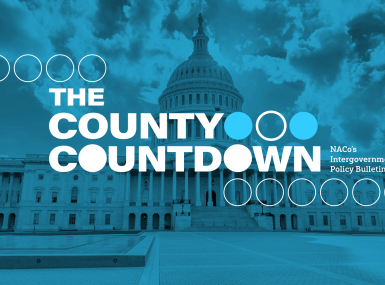Primer for Counties: The Transformative Power of Artificial Intelligence

Upcoming Events
Related News
The advent of generative artificial intelligence across the world presents unique opportunities and challenges for county governments. NACo established the Artificial Intelligence Exploratory Committee in July 2023 to build a knowledge base and best practices resources hub for counties.
This primer will offer an overview of artificial intelligence and generative artificial intelligence, share the work of NACo’s Artificial Intelligence Exploratory Committee, and provide a list of resources that NACo will plan to debut at the NACo 2024 Annual Conference
Overview
The advent of generative artificial intelligence across the world presents unique opportunities and challenges for county governments. NACo established the Artificial Intelligence Exploratory Committee in July 2023 to build a knowledge base and best practices resources hub for counties.
This primer will offer an overview of artificial intelligence and generative artificial intelligence, share the work of NACo’s Artificial Intelligence Exploratory Committee, and provide a list of resources that NACo will plan to debut at the NACo 2024 Annual Conference.
Introduction to Artificial Intelligence and Its Relevance to Counties
Understanding AI and Generative AI
Artificial Intelligence
Technical Definition
The theory and development of computer systems able to perform tasks that normally require human intelligence, such as visual perception, speech recognition, decision- making, and translation between languages. Other examples include devices such as security cameras, software applications such as computer monitoring and HVAC systems that automate heating/cooling.
Layman’s Definition
AI is like a digital assistant automating processes that organize data for employees to make informed decisions. Examples include smart devices such as lights in the courthouse or self- driving cars that collect data. Other examples include transcribing apps, voice command prompts, and customer relationship management scripts used in chatbots. This is similar to a behind-the-scenes advisor.
Generative Artificial Intelligence
Technical Definition
The development and deployment of artificial systems that can generate novel content by relying on large language models, data sets, and other methods of machine learning, including inputs from humans. Examples include ChatGPT, Copilot, Google Bard, Einstein, Claude, Otter.ai, etc.
Layman’s Definition
Generative AI, such as ChatGPT, acts like a creative advisor, not only assisting in regular tasks but also capable of drafting legal documents, designing educational materials, or creating public service announcements, showcasing its ability to produce new and original content when you ask it questions, otherwise known as Prompts.
Basic Terminology and Concepts of Artificial Intelligence
Automation is the use of technology (software, rules, triggers, actions) to perform tasks where little to no human input is needed. Generally used to replace or minimize manual tasks that are repeatable.
Machine learning, a subfield of artificial intelligence, focuses on the use of data and algorithms to create models that enable machines to perform like humans. Machine learning often powers many of the digital goods and services we use every day. Machine learning is widely used today for such things as recommending products to consumers based on their past purchases and translating text from one language to another.
Natural language processing (NLP), also a subset of artificial intelligence, refers to the process of making human communication, such as speech and text, understood by computers. Some of the most common ways NLP is used include voice-activated digital assistants on smartphones, email-scanning programs used to identify spam, and translation apps that decipher foreign languages.
Large language models (LLMs) are a category of models that are pre-trained on vast amounts of data, making them capable of understanding and generating natural language and other types of content to perform a wide variety of tasks. Such large-scale models can ingest massive amounts of data, often from the internet, as well as other data sets such as Reddit or X (formerly Twitter).
Prompts are text that you type or say to a generative artificial intelligence tool that is then used to provide context and guidance to machine learning models. One will hear of the term prompts quite often when receiving education and training on generative AI (ChatGPT or BingChat for example)
Working Group Progress
NACo’s AI Exploratory Committee
NACo’s Artificial Intelligence Exploratory Committee was formally established in July 2023 to explore the role of counties in utilizing generative artificial intelligence in county operations, constituent services, communications, and more. The committee is also tasked with exploring the risks and benefits of the role of generative artificial intelligence in society and the economy.
The AI Exploratory Committee is actively building out recommendations among four workgroups: Policy, Ethics, Applications, and Workforce. The committee will debut a final report by the NACo 2024 Annual Conference in Hillsborough County, Florida in July 2024.

Policy Workgroup
The Policy Workgroup is tasked with exploring the policy implications for regulating, monitoring, guarding, and promoting the use and application of artificial intelligence in county governance and operations as well as across various sectors in the broader economy. Conclusions from this group will focus on the county perspective and areas of potential contribution to a broader policy lens.
Ethics Workgroup
The Ethics Workgroup is developing ethical principles in the use of artificial intelligence. This working group will identify challenges with respect to bias, equity concerns with respect to adoption and utilization of artificial intelligence, privacy of use, accountability for decisions made based on AI technology, transparency of services, and ensuring human dignity is prioritized.
Ethical Principles for AI must include: Equity, Transparency, Privacy and Accountability for use of AI in government services and applications.
Applications Workgroup
The Applications Workgroup is identifying and evaluating current use cases of generative artificial intelligence. The working group will similarly seek to identify risks of applying artificial intelligence to county services and operations. The working group will utilize the National Institute of Standards and Technology (NIST) AI Risk Management Framework as a basis for determining best applications of AI.
- Establish infrastructure and technical requirements for implementation of systems
- Identify necessary hardware and software for implementation of artificial intelligence
- Strategize on data management practices, including data collection, storage, protection, and analysis
- Ensure security, including implementing cyber- security measures and protecting against breaches
NIST emphasizes a playbook that encourages governance by measuring, managing and mapping the risks.
Workforce Workgroup
The Workforce Workgroup is assessing opportunities for the future of promoting employee skills and exploring opportunities for upskilling the county workforce to integrate artificial intelligence in a productive and non-disruptive manner. This working group is also considering broader dynamics on the implementation of artificial intelligence and implications for the workforce.
The focus is on skills development and capacity building, including:
- Providing accessible training for various county staff roles, including administrative, programmatic, technical, and executive
- Ensuring ongoing learning and development in artificial intelligence and related technologies is a continued focus
Featured Initiative
Artificial Intelligence Exploratory Committee
The AI Exploratory Committee examined and developed resources on emerging policies, practices and potential applications and consequences of AI through the lens of county governance, operations, constituent services, innovation, public trust, privacy, security, and workforce productivity.

The Marvelous Adventures of Countyland
With county government policymakers and practitioners now facing the realities of generative artificial intelligence (AI), this book was developed with three main objectives:
- Showcase the remarkable capabilities and intricate nature of contemporary AI technologies
- Stimulate collaborative policy discussions among intergovernmental partners regarding the near limitless applications within the public sector, taking into account the possible inherent biases in AI systems, and
- Inspire the young people of America to explore the exciting and meaningful roles and responsibilities of county government officials.







